Hershey and chase Guías de estudio, Notas de estudios & Resúmenes
¿Buscas las mejores guías de estudio, notas de estudio y resúmenes para Hershey and chase? En esta página encontrarás 234 documentos de estudio para Hershey and chase.
Página 2 fuera de 234 resultados
Ordenador por
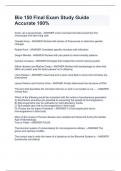
-
Bio 150 Final Exam Study Guide Accurate 100%
- Examen • 10 páginas • 2024
-
Disponible en paquete
-
- $11.99
- + aprende más y mejor
Anton van Leeuwenhoek - ANSWER Linen merchant that discovered the first microscope and saw living cells Oswald Avery - ANSWER Worked with strains of Pneumonia to determine genetic changes Robert Koch - ANSWER Correlated specific microbes with infections Gregor Mendel - ANSWER Worked with pea plants to show heredity patterns Carolus Linnaeus - ANSWER Zoologist that created the current naming system Alfred Hershey and Martha Chase - ANSWER Worked with bactiophage to show that DNA no...
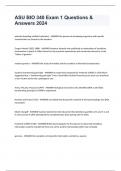
-
ASU BIO 340 Exam 1 Questions & Answers 2024
- Examen • 18 páginas • 2024
-
Disponible en paquete
-
- $9.99
- + aprende más y mejor
ASU BIO 340 Exam 1 Questions & Answers 2024 selective breeding (artificial selection) - ANSWER-the process of developing organisms with specific characteristics as chosen by the breeders Gregor Mendel () - ANSWER-Amateur botanist who published an explanation of hereditary transmission in plants in 1866. Known for his pea-plant experiments and commonly referred to as the "father of genetics" modern genetics - ANSWER-the study of heredity and the variation of inherited characteristics...
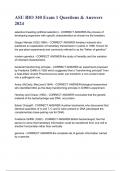
-
ASU BIO 340 Exam 1 Questions & Answers 2024
- Examen • 19 páginas • 2024
-
Disponible en paquete
-
- $7.99
- + aprende más y mejor
ASU BIO 340 Exam 1 Questions & Answers 2024 selective breeding (artificial selection) - CORRECT ANSWER-the process of developing organisms with specific characteristics as chosen by the breeders Gregor Mendel () - CORRECT ANSWER-Amateur botanist who published an explanation of hereditary transmission in plants in 1866. Known for his pea-plant experiments and commonly referred to as the "father of genetics" modern genetics - CORRECT ANSWER-the study of heredity and the variation of inhe...
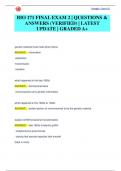
-
BIO 171 FINAL EXAM 2 | QUESTIONS & ANSWERS (VERIFIED) | LATEST UPDATE | GRADED A+
- Examen • 20 páginas • 2024
-
- $10.89
- + aprende más y mejor
genetic material must meet what criteria ANSWER: -information -replication -transmission -variation what happened in the late 1800s ANSWER: -biochemical basis -chromosomes carry genetic information what happened in the 1920s to 1940s ANSWER: -protein portion of chromosomes to be the genetic material explain Griffith's bacterial transformation ANSWER: -late 1920s Frederick griffith - streptococcus pneumoniae - staring that secrete capsules look smooth (fatal in mice) Deeagles - S...
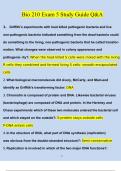
-
BIOD210 Exam MODULE 5 Study Guide | Questions with 100% Correct Answers | Verified | Updated 2024
- Examen • 19 páginas • 2024
-
- $12.99
- + aprende más y mejor
1. Griffith's experiments with heat killed pathogenic bacteria and live non-pathogenic bacteria indicated something from the dead bacteria could do something to the living, non-pathogenic bacteria that he called transfor- mation. What changes were observed in colony appearance and pathogenic- ity?: When the heat-killed S cells were mixed with the living R cells they combined and formed living S cells- smooth encapsulated cells 2. What biological macromolecule did Avery, McCarty, and MacLeod i...

-
Biology 1406 exam 5 questions and answers already passed
- Examen • 8 páginas • 2024
-
- $7.99
- + aprende más y mejor
In 1928, __________ was surprised to find that when he killed pathogenic bacteria, then mixed the bacterial remains with living harmless bacteria, some living bacterial cells became pathogenic. Frederick Griffith In 1952, ___________ used bacteriophages to show that DNA is the genetic material of T2, a virus that infects the bacterium Escherichia coli (E. coli). Hershey-Chase __________ are viruses that infect bacterial cells. Bacteriophages ______ discovered the relationships between D...
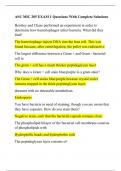
-
ASU MIC 205 EXAM 1 Questions With Complete Solutions
- Examen • 35 páginas • 2023
-
Disponible en paquete
-
- $12.99
- + aprende más y mejor
Hershey and Chase performed an experiment in order to determine how bacteriophages infect bacteria. What did they find? The bacteriophage injects DNA into the host cell. This was found because, after centrifugation, the pellet was radioactive The largest difference between a Gram + and Gram - bacterial cell is: The gram + cell has a much thicker peptidoglycan layer Why does a Gram + cell stain blue/purple in a gram stain? The Gram + cell stains blue/purple because crystal violet rem...

-
Biology ABCTE Certification Test Part 1 questions well answered graded A+ 2024/2025
- Examen • 9 páginas • 2024
- Disponible en paquete
-
- $14.99
- + aprende más y mejor
Biology ABCTE Certification Test Part 1genetic drift - correct answer The following phenomena affect Hardy-Weinberg equilibrium. Which one is associated with small populations and chance changes in allele frequency? allantois - correct answer Which embryonic membrane develops into the umbilical cord in placental mammals? separation of homologous chromosomes during meiosis - correct answer Mendel observed that pea color was a characteristic passed independently of flower color. What caus...
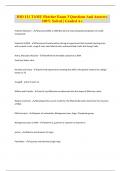
-
BIO 111 TAMU Fletcher Exam 3 Questions And Answers 100% Solved | Graded A+
- Examen • 9 páginas • 2024
- Disponible en paquete
-
- $11.48
- + aprende más y mejor
BIO 111 TAMU Fletcher Exam 3 Questions And Answers 100% Solved | Graded A+ Friedrich Miescher - discovered DNA in 1869 But did not know (Isolated phosphate) rich acidic compounds Frederick Griffith - Discovered transformation during an experiment that involved injecting mice with smooth S cells, rough R cells, heat-killed S cells, and heat-killed S cells with living R cells. Avery, MacLeod, McCarty - Identified the heritable substance as DNA Used test tubes- vitro Hershey and Chase - per...
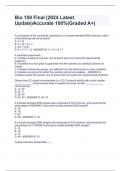
-
Bio 150 Final (2024 Latest Update)Accurate 100%(Graded A+)
- Examen • 32 páginas • 2024
-
Disponible en paquete
-
- $12.99
- + aprende más y mejor
Bio 150 Final (2024 Latest Update)Accurate In an analysis of the nucleotide composition of a double stranded DNA molecule, which of the following will not be found? A. C = G B. C + G = A + T C. A/T = C/G D. A - C = T - G - ANSWER B. C + G = A + T A controlled experiment.... A. Includes at least two groups, one of which does not receive the experimental treatment. B. Proceeds at a slow pace to guarantee that the scientist can carefully observe all results. C. Includes at least two gro...

Ese resumen que acabas de comprar ha hecho muy feliz a alguien. ¿También te pagan semanalmente? ¡Vende tus documentos de estudio en Stuvia! Descubre todo sobre cómo ganar en Stuvia


